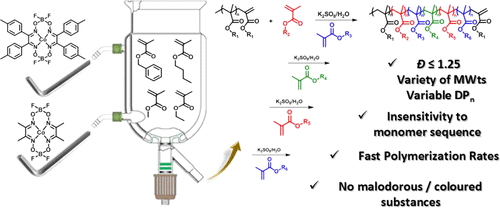当前位置:
X-MOL 学术
›
Macromolecules
›
论文详情
Our official English website, www.x-mol.net, welcomes your feedback! (Note: you will need to create a separate account there.)
Sequence-Controlled Methacrylic Multiblock Copolymers: Expanding the Scope of Sulfur-Free RAFT
Macromolecules ( IF 5.5 ) Pub Date : 2018-01-02 00:00:00 , DOI: 10.1021/acs.macromol.7b01987 Nikolaos G. Engelis 1 , Athina Anastasaki 1 , Richard Whitfield 1 , Glen R. Jones 1 , Evelina Liarou 1 , Vasiliki Nikolaou 1 , Gabit Nurumbetov 1 , David M. Haddleton 1
Macromolecules ( IF 5.5 ) Pub Date : 2018-01-02 00:00:00 , DOI: 10.1021/acs.macromol.7b01987 Nikolaos G. Engelis 1 , Athina Anastasaki 1 , Richard Whitfield 1 , Glen R. Jones 1 , Evelina Liarou 1 , Vasiliki Nikolaou 1 , Gabit Nurumbetov 1 , David M. Haddleton 1
Affiliation

|
Sulfur-free reversible addition–fragmentation transfer polymerization (SF-RAFT) in emulsion allows access to the synthesis of sequence-controlled methacrylic multiblock copolymers. Herein, we expand the scope of SF-RAFT emulsion polymerization by utilizing four different macrochain transfer agents (mCTA) to mediate the synthesis of diblocks and sequence-controlled methacrylic multiblock copolymers. Poly(methyl methacrylate) (pMMA), poly(butyl methacrylate) (pBMA), poly(ethyl methacrylate) (pEMA), and poly(benzyl methacrylate) (pBzMA) of a similar Mn (∼4300 g mol–1) were successfully synthesized via catalytic chain transfer polymerization (CCTP) in emulsion. The capability of these mCTAs to act as macroinitiators was investigated through the synthesis of “in situ” diblock copolymers and was then expanded to the synthesis of deca- and hexablock multiblock copolymers with varying degrees of polymerization (DPn = 10–50 per block, Mn,total = 7000–55 000 g mol–1), yielding well-defined copolymers with controlled molecular weights, quantitative conversions (>99%), and low dispersities (Đ ∼ 1.2) without employing sulfur or transition metal reagents.
中文翻译:

顺序控制的甲基丙烯酸多嵌段共聚物:扩大了无硫RAFT的范围
乳液中的无硫可逆加成-片段转移聚合(SF-RAFT)可以实现顺序控制的甲基丙烯酸多嵌段共聚物的合成。在这里,我们通过利用四种不同的大链转移剂(mCTA)来介导二嵌段和顺序控制的甲基丙烯酸多嵌段共聚物的合成,扩大了SF-RAFT乳液聚合的范围。聚甲基丙烯酸甲酯(pMMA),聚甲基丙烯酸丁酯(pBMA),聚甲基丙烯酸乙酯(pEMA)和相似的M n(〜4300 g mol –1)聚甲基丙烯酸苄酯(pBzMA )为通过催化链转移聚合(CCTP)在乳液中成功合成。通过综合“原位”二嵌段共聚物,然后扩展到具有不同聚合度的十嵌段和六嵌段多嵌段共聚物的合成(DP n =每嵌段10–50,Mn ,总计= 7,000–55 000 g mol –1),定义明确的共聚物,具有可控制的分子量,定量转化率(> 99%)和低分散性(Đ〜1.2),无需使用硫或过渡金属试剂。
更新日期:2018-01-02
中文翻译:

顺序控制的甲基丙烯酸多嵌段共聚物:扩大了无硫RAFT的范围
乳液中的无硫可逆加成-片段转移聚合(SF-RAFT)可以实现顺序控制的甲基丙烯酸多嵌段共聚物的合成。在这里,我们通过利用四种不同的大链转移剂(mCTA)来介导二嵌段和顺序控制的甲基丙烯酸多嵌段共聚物的合成,扩大了SF-RAFT乳液聚合的范围。聚甲基丙烯酸甲酯(pMMA),聚甲基丙烯酸丁酯(pBMA),聚甲基丙烯酸乙酯(pEMA)和相似的M n(〜4300 g mol –1)聚甲基丙烯酸苄酯(pBzMA )为通过催化链转移聚合(CCTP)在乳液中成功合成。通过综合“原位”二嵌段共聚物,然后扩展到具有不同聚合度的十嵌段和六嵌段多嵌段共聚物的合成(DP n =每嵌段10–50,Mn ,总计= 7,000–55 000 g mol –1),定义明确的共聚物,具有可控制的分子量,定量转化率(> 99%)和低分散性(Đ〜1.2),无需使用硫或过渡金属试剂。



























 京公网安备 11010802027423号
京公网安备 11010802027423号